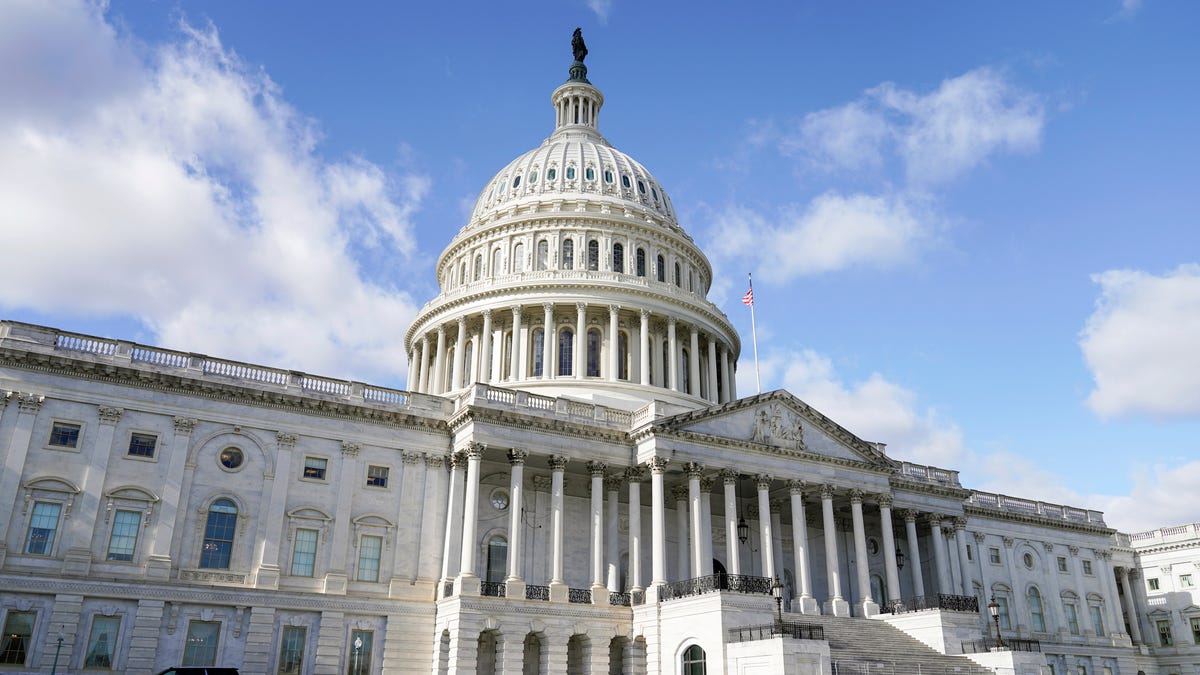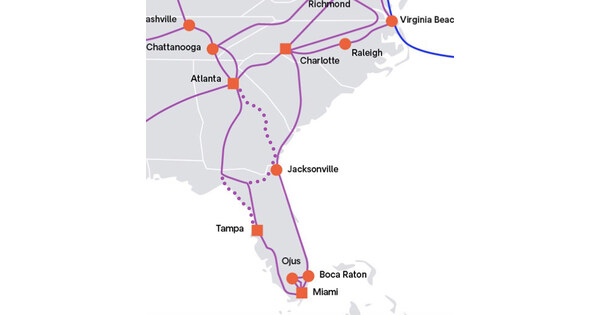Ohio
Who will control Congress after 2024? These are the most vulnerable seats heading into a tight race

Trump removed from primary ballot among multiple legal battles
Former President Donald Trump will likely appeal to the Supreme Court after being removed from Colorado’s primary ballot.
WASHINGTON – There are hundreds of House and Senate lawmakers up for reelection in 2024. But just a handful of seats will determine control of Congress and give Americans the opportunity to send a message about which party they want at the wheel.
While all eyes will be on the presidential race next year, congressional elections will also determine whether the next president can pass their agenda, or whether Washington will face further gridlock.
In the House, Republicans are seeking to defend and expand their razor-thin majority. Meanwhile, Democrats are eying crucial battleground districts held by the GOP that President Joe Biden won in the 2020 election.
Senate Democrats are hoping to hold on to their majority as they face significant headwinds among vulnerable incumbents in solidly red states.
Here are the races to keep an eye on heading into 2024.
The Biden 17
When it comes to control of the House, much of the focus will be on the 17 Republicans representing districts Biden won in the 2020 presidential election.
House Republicans are trying to defend their majority as they continue their impeachment inquiry into Biden, among other investigations and conservative priorities. But as Democrats seek to recapture the lower chamber, these 17 races will be central in determining who wins the House.
- Rep. David Schweikert, R-Ariz.
- Rep. Juan Ciscomani, R-Ariz.
- Rep. John Duarte, R-Calif.
- Rep. David Valadao, R-Calif.
- Rep. Mike Garcia, R-Calif.
- Rep. Young Kim, R-Calif.
- Rep. Michelle Steel, R-Calif.
- Rep. Don Bacon, R-Neb.
- Rep. Tom Kean Jr., R-N.J.
- Rep. Nick LaLota, R-N.Y.
- Rep. Anthony D’Esposito, R-N.Y.
- Rep. Mike Lawler, R-N.Y.
- Rep. Marc Molinaro, R-N.Y.
- Rep. Brandon Williams, R-N.Y.
- Rep. Lori Chavez-DeRemer, R-Ore.
- Rep. Brian Fitzpatrick, R-Pa.
- Rep. Jen Kiggans, R-Va.
Not all of these lawmakers will necessarily lose their seats, and Republicans also have their own share of pick up opportunities heading into 2024. In Michigan, Democratic Reps. Elissa Slotkin and Dan Kildee are leaving their competitive districts, opening up their seats for Republicans’ taking. Slotkin is running for the Senate, while Kildee is retiring.
Montana’s Senate race offers GOP opportunity
Republicans have high hopes of reclaiming the Senate as Democrats play defense in two critical states former President Donald Trump won in the 2020 election: Montana and Ohio.
Sen. Jon Tester, D-Mont., is running for a fourth term and has already won three tough elections in deep-red Montana. Testers’ chances of victory rely largely on whether ultraconservative Rep. Matt Rosendale, R-Mont., steps into the GOP primary.
Republicans in Washington are coalescing behind Tim Sheehy, an aerospace company CEO and a retired Navy SEAL, to take on Tester next year. But Rosendale, who already ran against Tester and lost in 2018, has repeatedly teased jumping into the race again.
A competitive primary between Sheehy and Rosendale threatens to consume valuable GOP campaign resources and weaken the ultimate Republican nominee, potentially paving a way for Tester to win a fourth term.
Will Sherrod Brown defend his seat in Ohio?
Sen. Sherrod Brown, D-Ohio, like Tester, is also running for a fourth term. In recent presidential elections, Ohio has slowly trended right, fostering a favorable environment for Republicans.
GOP lawmakers are hoping to carry forward their momentum in the state from the 2022 midterm elections. During that race, now-Sen. J.D. Vance, R-Ohio, beat back Democratic hopes of flipping the seat, which was previously held by a Republican.
Going into 2024, the GOP has a chance to unseat Brown. Unlike Montana, Washington Republicans have largely avoided wading into the Republican primary, which is contested by three candidates: businessman Bernie Moreno, state Sen. Matt Dolan and Ohio Secretary of State Frank LaRose.
Moreno has earned the endorsement of Trump and Vance. Vance in 2022 secured the GOP nomination in part because of the former president’s backing.
But Brown has brushed off the tough race, saying in an interview with the USA TODAY Network Ohio Bureau “This campaign’s no different from any other.”
“Campaigns are about whose side you’re on. The reason I win is that voters in Ohio know that I’m on their side,” he said.
Will Arizona see a historic race?
Arizona, a notorious purple swing state, could see an unprecedented three-way race in 2024. Incumbent Sen. Kyrsten Sinema, I-Ariz., has not revealed whether she plans to run for reelection. Sinema left the Democratic Party in 2022 and has frequently drawn criticism from Democrats for bucking them on contentious issues.
Rep. Ruben Gallego, D-Ariz., is the only prominent candidate running for the Democratic nomination. On the Republican side, conservative firebrand Kari Lake, the GOP’s 2022 failed gubernatorial candidate, is running against Mark Lamb, a pro-Trump sheriff.
Sinema has pitched her still-undeclared campaign to prospective donors as built on overwhelmingly winning independent voters and siphoning more support from Republicans than Democrats, the Arizona Republic, part of the USA TODAY Network, reported.
A memo to potential supporters included a pie chart suggesting she could claim 60% to 70% of Arizona’s independent voters. Her campaign sees her taking 10% to 20% of Democratic voters and 25% to 35% of Republicans.

Ohio
AEP Ohio: Data center electricity demands to put central Ohio on same tier as Manhattan.

AEP Ohio is asking state regulators to sign off on a new plan to deal with the surge in data centers in central Ohio that is expected to eat up so much electricity in coming years that demand for power in the region will be similar to all of Manhattan.
The power company on Monday asked the Public Utilities Commission of Ohio to require data centers to make a 10-year commitment to pay for a minimum of 90% of the electricity they request, even if they use less.
AEP says the new rate structure would also apply to cryptocurrency mining operations.
“In order to protect AEP Ohio customers and future economic development in its service territory, the company wants to help ensure that any large-scale transmission investment is right-sized to serve load that will show up at the time it is committed to show up,” AEP Ohio said in a filing with the PUCO. “This approach should help mitigate any risks that the load may not show up at the level and time indicated or that facilities will be overbuilt to serve the actual load that develops.”
“Demand for computing power from data centers, which require enormous amounts of electricity, is being fueled by artificial intelligence and other new technologies. AEP Ohio is seeing unprecedented demand from data center customers, especially in the central Ohio area,” Marc Reitter, AEP Ohio president and chief operating officer, said in a prepared release.
“While we see no concerns serving current or new residential and existing commercial or industrial customers, we need to ensure that the right long-term investments are made to the electric grid,” Reitter said. “We need accurate plans and solid commitments from large data center customers so the right facilities are built at the right time. This will help us keep Ohio open for business for all industries, while making sure customers aren’t paying for unused infrastructure.”
AEP said adding large users will require investment in new extra-high voltage transmission lines needed to bring more power to the region. Those lines can take seven to 10 years to plan and construct.
Historically, AEP said load growth was expected to be 1%-2% year over year.
“AEP has signed agreements that will nearly double the amount of load served in Ohio in just over five years’ time,” the company said in the filing. “The development of new transmission facilities to serve a new, significant amount of load is dependent upon the customer’s commitment to bringing such large loads online. The amount of investment required to connect in the amount of load already signed is a fraction of the cost required to connect the next batch of large hyperscale loads waiting to connect to the network.”
AEP’s transmission system in central Ohio is serving about 600 megawatts of load from data centers. That’s all come since 2017.
Since then Amazon, Google, Facebook and other companies have built data centers in the region. Amazon last summer announced a $7.8-billion expansion plan of its data service operations in central Ohio.
AEP has agreements for new demand from existing and additional customers to add 4,400 megawatts of power to central Ohio by 2030, making total demand for electricity in the region about equal to that of Manhattan, the company said.
The proposed rate commitment is meant to ensure that existing customers don’t pay for the needed infrastructure to meet the demand from these new customers, especially if they don’t ultimately connect to the system, the company said.
AEP Ohio, a unit of American Electric Power, provides electricity to 1.5 million customers.
mawilliams@dispatch.com
@BizMarkWilliams
Ohio
Ohio State Buckeyes vs. Michigan Wolverines Broadcast Info Officially Revealed

Whether they’d like to admit it or not, the Ohio State Buckeyes and coach Ryan Day have likely already had next season’s matchup with the Michigan Wolverines circled on the calendar considering the heartbreaking results of 2023.
Now, fans officially know how to watch the 2024 edition of “The Game,” which will be in Columbus this time around.
FOX Sports revealed Monday that Ohio State-Michigan will once again be on “Big Noon Kickoff,” meaning the game will kickoff at 12 p.m. ET on Saturday, Nov. 30. This was already the expectation considering the rivalry matchup has been in that time slot for the past handful of seasons, and now it’s confirmed.
FOX also announced that Texas at Michigan (Sept. 7) and Alabama at Wisconsin (Sept. 14) will also be “Big Noon Kickoff” games.
Ohio State has lost the past three meetings with the Wolverines, but the 2023 loss was probably the hardest to swallow yet. The defeat prevented the Buckeyes from playing the Big Ten title game and essentially kept them out of the College Football Playoff.
Ohio State quarterback Kyle McCord, who has since transferred to Syracuse, was looking to lead a potential game-winning drive in the final minute as the Buckeyes trailed by six. Instead, his final pass attempt to Marvin Harrison Jr. was intercepted, as Michigan secured the 30-24 victory.
The Wolverines used that game as a springboard to an eventual win in the National Championship, which capped off an undefeated season.
Ohio
‘Day Without Childcare’ demonstrators to Ohio lawmakers: ‘Show us the money!’

COLUMBUS, Ohio—More than 250 childcare centers around Ohio were closed Monday to mark the third annual Day Without Childcare, meant to draw attention to efforts to make childcare more affordable and raise wages for providers, according to organizers of the effort.
Many of those childcare teachers and parents of kids in childcare spent part of the day in Columbus demonstrating in front of the Ohio Statehouse. The protesters called on lawmakers to pass a variety of reforms and policy changes, though most of them had a common theme.
“What did Jerry McGuire say?” said Nefree Cook, a Cincinnati childcare provider, on the Statehouse steps.
“Show me the money!” the crowd of a couple hundred people shouted back.
“That’s what we need – show us the money!” Cook replied.
Monday’s Statehouse rally comes as Ohio and other states are in the midst of a childcare crisis. Ohio parents, on average, pay more for childcare than what they pay in rent while – seemingly paradoxically – many providers can’t offer wages high enough to maintain staff.
While Ohio lawmakers on both sides of the aisle have started to pay more attention to the problem, under pressure from business groups that say it threatens the state’s growing job market, speaker after speaker at Monday’s rally said the problem will continue until there’s a large influx of government funding.
The CEO (Caring Economy Organizing) Project, a division of the left-leaning Ohio Organizing Collaborative, said in a release that it organized Monday’s Statehouse rally to call for, among other things:
- Raising income eligibility for publicly funded childcare in Ohio from up to 142% of the federal poverty line ($39,405 per year for a family of four) to those making up to 300% of the poverty line, or $83,250 annually for a four-person family
- Raising Ohio’s childcare subsidies so that families qualifying for aid have access to the cheapest 75% of child-care centers in their area. Right now, Ohio’s base reimbursement rates cover only the cheapest 35% of childcare options.
- Offering a refundable state tax credit of up to $1,000 per year to lower- and middle-income families with children
- Making the state’s Earned Income Tax Credit refundable, meaning lower-income Ohioans who qualify would receive a refund even if they don’t owe any state income tax.
- Providing more money in general for state childcare programs.
It remains to be seen what all these initiatives, if passed, would cost, though, at bare minimum, it would require hundreds of millions of dollars.
“We want to see the state invest in our families in an equitable way,” said Tami Lunan, director of the CEO Project, in an interview. “That’s the main thing we want to lift up.”
Monday’s rally specifically focused on helping childcare providers who are women and/or racial minorities; the majority of attendees were women of color.
Lunan said the rally’s organizers are planning to hold similar rallies on a “much larger scale” in the future.
Closing childcare centers for a day, Lunan said, shows people the importance of childcare and why it’s worth fighting to improve the childcare system. Providers, she said, make sure to tell parents why they’re closing for the day – in part to convince them to come out themselves to demonstrate.
“The idea’s to show the economic impact,” she said. “We believe that that’s the only way that these women, who are business owners, are going to be seen.”
Lunan said childcare advocates are pushing lawmakers to include their policy goals in next year’s two-year state budget plan.
Until a few months ago, Ohio’s child care subsidy rates for poorer families were tied for the lowest of any state in the nation. That led the federal government to demand that Ohio raise their rates or face penalties.
As a result, Gov. Mike DeWine’s administration is now seeking to raise base reimbursement rates to the 50th percentile — not by increasing spending, but by reducing financial incentives to child care facilities with high ratings in the Step Up To Quality program. Another proposed change would reduce Step Up To Quality’s current five-tier ratings system with a three-tiered one.
Lunan said she’s opposed to the proposed changes, saying instead lawmakers should have responded to federal demands by including more money for childcare in last year’s state budget bill. A three-tier ratings system, she said is “still not equitable.”
Jeremy Pelzer covers state politics and policy for Cleveland.com and The Plain Dealer.
-
News1 week ago
A group of Republicans has united to defend the legitimacy of US elections and those who run them
-

 Politics1 week ago
Politics1 week agoHouse Dems seeking re-election seemingly reverse course, call on Biden to 'bring order to the southern border'
-

 Movie Reviews1 week ago
Movie Reviews1 week agoExhuma Movie Review: An effective horror film steeped in myth, legends, and realism
-

 World1 week ago
World1 week ago‘It’s going to be worse’: Brazil braces for more pain amid record flooding
-

 Politics1 week ago
Politics1 week ago'Stop the invasion': Migrant flights in battleground state ignite bipartisan backlash from lawmakers
-

 World1 week ago
World1 week agoGerman socialist candidate attacked before EU elections
-

 World1 week ago
World1 week agoSpain and Argentina trade jibes in row before visit by President Milei
-

 Politics1 week ago
Politics1 week agoRepublicans believe college campus chaos works in their favor

















